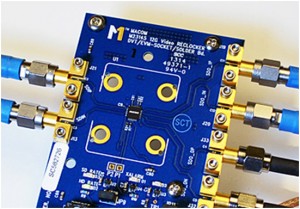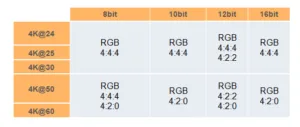Connectivity – There are lots of ways to deliver UltraHD video, but each solution has its own limitations and/or idiosyncrasies. In the home and some professional AV installations, HDMI 2.0 is emerging as the next generation solution for UltraHD. In the broadcast market, 12G solutions are being shown for those who want to stick with SDI. At IBC 2014, Altera showed how both standards can be implemented in the FPGAs.
The HDMI 2.0 standard represents a big step up in capabilities for this uncompressed video connectivity standard. For example, compared to the 1.4a standard, data rates moved from 10.2 Gbps to 18 Gbps, although with about 20% of overhead, only about 14.4 Gbps can be devoted to delivering UHD video. UltraHD content at a resolution of 4096 x 2160 can be played out at 60 fps. But you have to ask at what bit depth and what color sub-sampling rate? Below is a table from HDMI showing the various supported 4K/UHD options in HDMI 2.0.
Frankly, we are not quite sure how these modes are supported as simple data rate calculations suggest some of them will require the full 18 Gbps, suggesting there is no overhead (and signal integrity) included to allow these modes.
At IBC, Altera showed how their IP core has now been implemented in an FPGA solution – the first of its kind, it is claimed. Altera also offers a video processing IP core that can easily be added to the HDMI 2.0 transceiver core.
To showcase the capability, Altera used an Arri Amira camera as the source (also with an Altera FPGA video processing pipeline) to output an HD video signal over HDMI. This was fed to the reference design with the Altera video processing and HDMI 2.0 cores to upscale and output over an HDMI 2.0 cable.
The other connectivity demo of note was the 12G SDI demo. A 12G SDI protocol has not yet been approved by SMPTE – 3G SDI which allows for a 3Gbps data rate is the current standard for HD content. To distribute UltraHD content requires four 3G connectors and cables, so a single cable solution that has four times the data rate is clearly needed in a broadcast environment.
We first saw an early prototype of this at NAB last April. At the time, Altera showed the breadboard solution with a Stratix V FPGA and with clocking chips and line drivers from Texas Instruments. At IBC 2014, Altera demonstrated interoperability with 12G SDI streams from the Tektronix AWG 70002 waveform generator and BlackMagic Teranex Express.
 M/A-Com Technology’s 12G board
M/A-Com Technology’s 12G board
For IBC, Altera moved the 12G solution to its Stratix 10 FPGA, which offers 14 nm silicon that can be integrated into SoC with additional computational, memory and I/O modules. Altera’s Arria 10 features 20 nm silicon for the midrange FPGA market, offering solutions for UHD that will offer high performance, and yet be affordable and low in power use.
Altera wasn’t the only one at IBC with a 12G solution. M/A-Com Technology Solutions showed its solution running UHD content over a single coax cable for 200 feet. Its board solution includes the drivers, re-clocking and adaptive cable equalizer chips to expand the distance without bit loss. The company also showed 12G crosspoints for switchers. –Chris Chinnock

